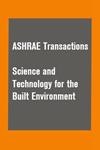ASHRAE RP-1814: Actual energy performance of secondary schools designed to comply with ASHRAE 90.1-2010, Part I – energy use and cost indices comparison
IF 1.7
4区 工程技术
Q3 CONSTRUCTION & BUILDING TECHNOLOGY
Science and Technology for the Built Environment
Pub Date : 2023-03-27
DOI:10.1080/23744731.2023.2194839
引用次数: 0
Abstract
K-12 school buildings constitute a substantial portion of commercial buildings in the U.S. and are responsible for significant energy consumption. This paper presents a nationwide study to investigate the actual energy performance of secondary school buildings constructed per the requirements of ASHRAE Standard 90.1 – 2004 and − 2010. A total of 73 building candidates are included in the analysis after careful screening and inspection, which covers eight ASHRAE climate zones. A Python-based Change Point Model (CPM) is developed to normalize the energy consumption data of the selected 73 buildings following the ASHRAE procedure. The energy use indices (EUI) and energy cost indices (ECI) of single buildings and the aggregated average of all buildings are computed to evaluate the actual energy performance of secondary school buildings. The results suggest that the actual national aggregated average EUI of secondary school buildings is 61 and 41 kBTU/(sq. ft. yr) for buildings designed per ASHRAE Standard 90.1 – 2004 and − 2010, respectively. This indicates a 20% saving in EUI and ECI for the update from the 2004 standard to 2010 one in real buildings, compared with a 38% saving-ratio obtained by Pacific Northwest National Laboratory (PNNL) in a nationwide simulation study.ASHRAE RP-1814:设计符合ASHRAE 90.1-2010的中学的实际能源性能,第一部分——能源使用和成本指数比较
K-12学校建筑构成了美国商业建筑的很大一部分,并造成了巨大的能源消耗。本文提出了一项全国性的研究,以调查根据ASHRAE标准90.1-2004和−2010的要求建造的中学建筑的实际能源性能。经过仔细筛选和检查,共有73座候选建筑被纳入分析,其中包括八个ASHRAE气候区。开发了一个基于Python的变点模型(CPM),以按照ASHRAE程序对选定的73栋建筑的能耗数据进行归一化。计算了单栋建筑的能源使用指数(EUI)和能源成本指数(ECI)以及所有建筑的总平均值,以评估中学建筑的实际能源性能。结果表明,对于按照ASHRAE标准90.1-2004和−2010设计的建筑,中学建筑的实际全国总平均EUI分别为61和41 kBTU/(平方英尺-年)。这表明,与太平洋西北国家实验室(PNNL)在一项全国性模拟研究中获得的38%的节约率相比,从2004年标准更新到2010年实际建筑的EUI和ECI节约了20%。
本文章由计算机程序翻译,如有差异,请以英文原文为准。
求助全文
约1分钟内获得全文
求助全文
来源期刊

Science and Technology for the Built Environment
THERMODYNAMICSCONSTRUCTION & BUILDING TECH-CONSTRUCTION & BUILDING TECHNOLOGY
CiteScore
4.30
自引率
5.30%
发文量
78
期刊介绍:
Science and Technology for the Built Environment (formerly HVAC&R Research) is ASHRAE’s archival research publication, offering comprehensive reporting of original research in science and technology related to the stationary and mobile built environment, including indoor environmental quality, thermodynamic and energy system dynamics, materials properties, refrigerants, renewable and traditional energy systems and related processes and concepts, integrated built environmental system design approaches and tools, simulation approaches and algorithms, building enclosure assemblies, and systems for minimizing and regulating space heating and cooling modes. The journal features review articles that critically assess existing literature and point out future research directions.
 求助内容:
求助内容: 应助结果提醒方式:
应助结果提醒方式:


